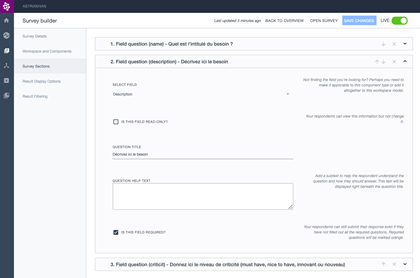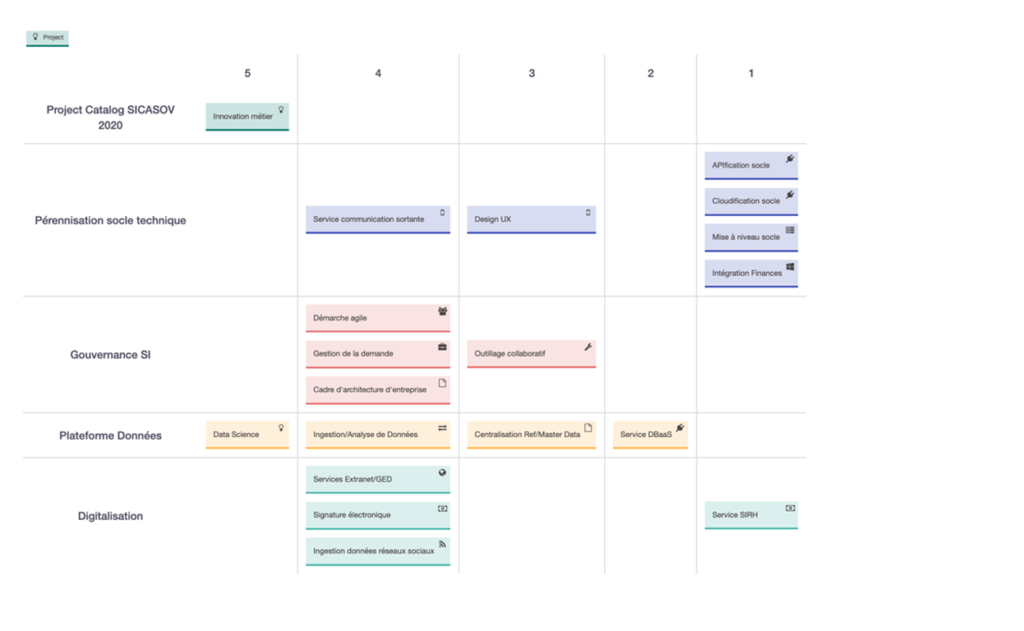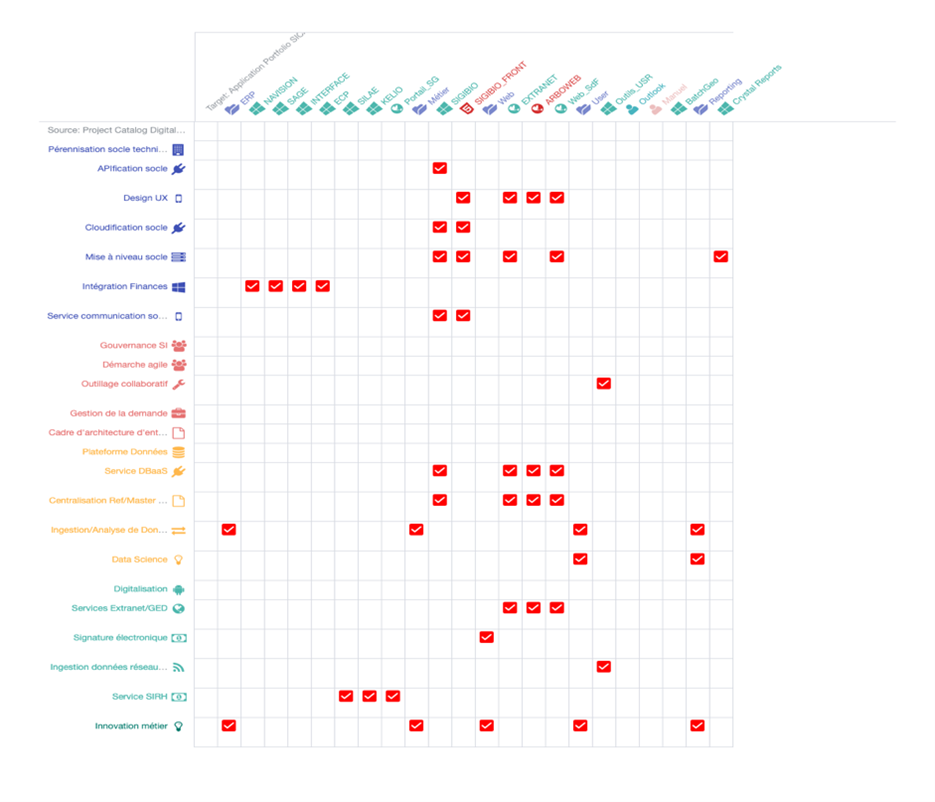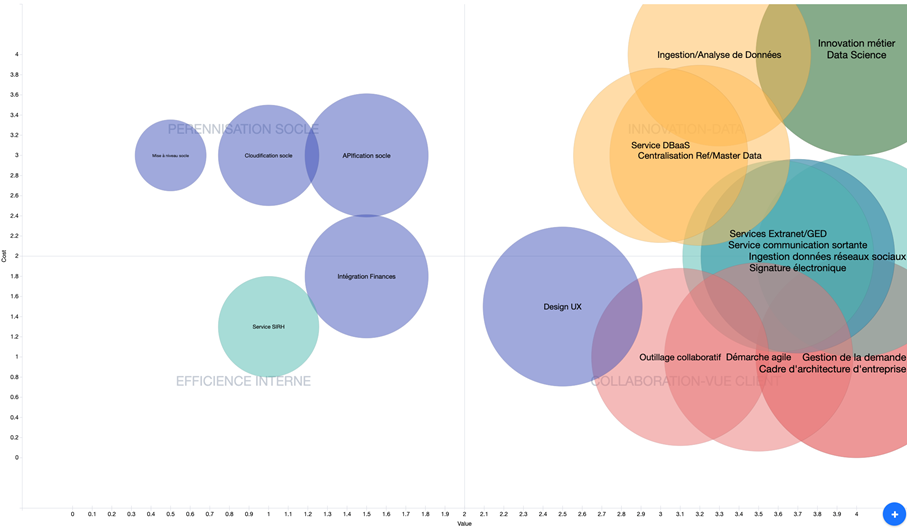In enterprise architecture, as in any other discipline, choosing the right tool suited to our needs from the wide range of available solutions can be time-consuming. To help you make your decision, we’re going to introduce you to “Ardoq”, a tool that we used to establish a digital transformation roadmap for one of our clients. After reviewing the client context, you’ll learn about the features of Ardoq that we used for this project.
An Enterprise Architecture tool dedicated to a Digital Transformation roadmap: experience feedback with Ardoq
A few months ago, we shared our convictions about the new challenge that Digital Transformation represents for Enterprise Architecture.
We then took up the new challenges of an agile and collaborative practice of Enterprise Architecture to drive the dual alignment with the changing and unpredictable evolutions of business models and business, as well as technological innovations generated by the Digital Transformation.
We continued with the central role played in an agile Enterprise Architecture model by the business capacity map, both in terms of its relationship to the company’s strategic challenges and its projections in terms of applications, data, and technology, in the context of a digital renovation of the information system; and its ability to carry out the value analyses required to prioritize the roadmap for the digital information system.
This approach, which is driven by the company’s challenges and added value, makes it possible to make the Enterprise Architecture factual by adapting it to the company’s context and, beyond its necessary sharing, to make it possible for all the players involved in the Digital Transformation project to make it their own.
We intend here to illustrate this approach with an example, inspired by an ongoing client project, concerning the audit and roadmap for the digital renovation of our client’s information system. On this occasion, we will share some examples of artifacts built with Ardoq, an innovative Norwegian company, publisher of a brand new generation of Enterprise Architecture tools, fully collaborative and offered in SaaS mode, and properly referenced by the companies Forrester and Gartner.
What is the client context?
Our client is a cooperative of plant breeders and has been managing the intellectual property rights entrusted to it for over 70 years. It is thus a trusted third party between the creators of plant varieties and the licensed producers who use them. Through these activities, our client establishes the framework for fair competition and contributes to the general dynamism of the agricultural sector. On the other hand, this small company, which is very modest in terms of workforce, deals with significant financial flows at the heart of its ecosystem. Its operations are based on a Legacy information system built nearly 20 years ago, which is currently being renovated in some areas and gradually upgraded with Web and Extranet satellite applications.
Our client decided to audit its information system and entrusted it to Astrakhan to ensure its technological durability, identify new service needs for internal and external use, and improve the way the relationship between the IT and business teams is organized.
This audit, which started two months ago, is now being finalized. We conducted it according to an agile Enterprise Architecture framework, characterized by short and agile workshops, and by an iterative capitalization of the existing system and needs in model spaces powered by Ardoq. Despite the current health crisis, we were able to carry out this mission remotely thanks to the collaborative means implemented (Teams, Ardoq), including workshops intentionally extended to a broad collaboration across all of our client’s departments (CEO, IT, Operations, CFO/HRD) and Astrakhan’s expertise (enterprise architect, digital expert, agility expert).
The first step was to collect business and IT elements of the existing system and to gather information on the system’s strengths and pain points. This phase was carried out via a series of workshops and was facilitated by Ardoq’s collaborative capabilities, especially the online collection of data via surveys generated by the tool.

The first artifacts of business capacity mapping and functional coverage by applications could then be built, iteratively.

Second step: the classification of the collected needs (business and technical evolutions) according to the stakes. This study and construction phase made it possible to identify all the projects to be carried out to consolidate, open up and perpetuate the technical base currently being renovated, meet the various business needs, and set up new digital services, including the enhancement of the company’s data. It also allowed us to classify these projects according to their added value (Business Strategic Fit),

and to project them on the application blocks in transition.

The modeling of these elements in Ardoq, facilitated by the artifact templates proposed by the tool (roadmap, dependency matrix), allowed us to share them visually and thus to share them in a way that was understandable for all the stakeholders involved.
The third step was the estimation of the projects to be implemented in terms of “perceived cost”. Using a “cost/value” model inspired by Lean Change Management practices, we were able to make all of the company’s stakeholders aware of the issues associated with the projects built, their usefulness, their contribution, and also their weight in terms of cost. This step, which is inherent to any Enterprise Architecture approach driven by the issues at stake, is particularly important in our case, given the misunderstandings and even frustrations that have built up over time between the IT and business teams.

Today, we are finalizing the audit with the last step of consolidation and collaborative construction and prioritization of the company-wide Digital Information System roadmap. Thanks to the participation of the CEO who was always supporting us throughout the audit, we will have contributed to the construction of the roadmap of the Digital Transformation of the information system of our client.
We have built a roadmap adapted to our client’s mission and medium- and long-term objectives, which were identified, reformulated, and shared during our mission. This roadmap takes full advantage of the technological innovations offered by digitalization (APIs, Cloud, Data/Enterprise Intelligence) docked coherently on the Legacy information system.
